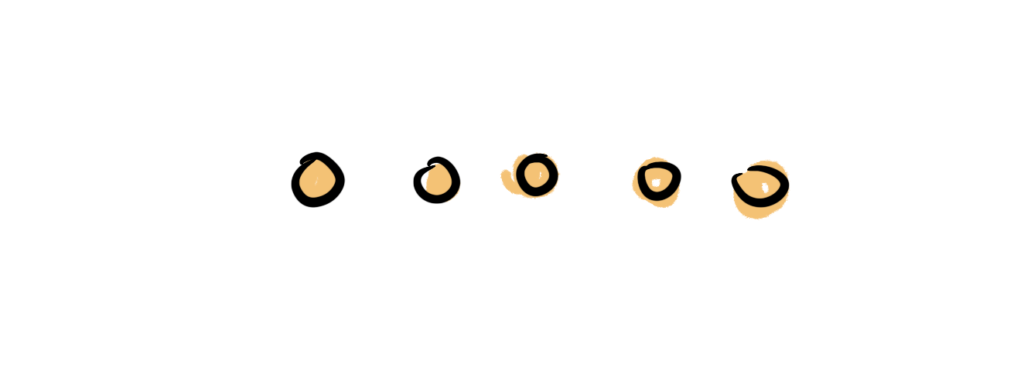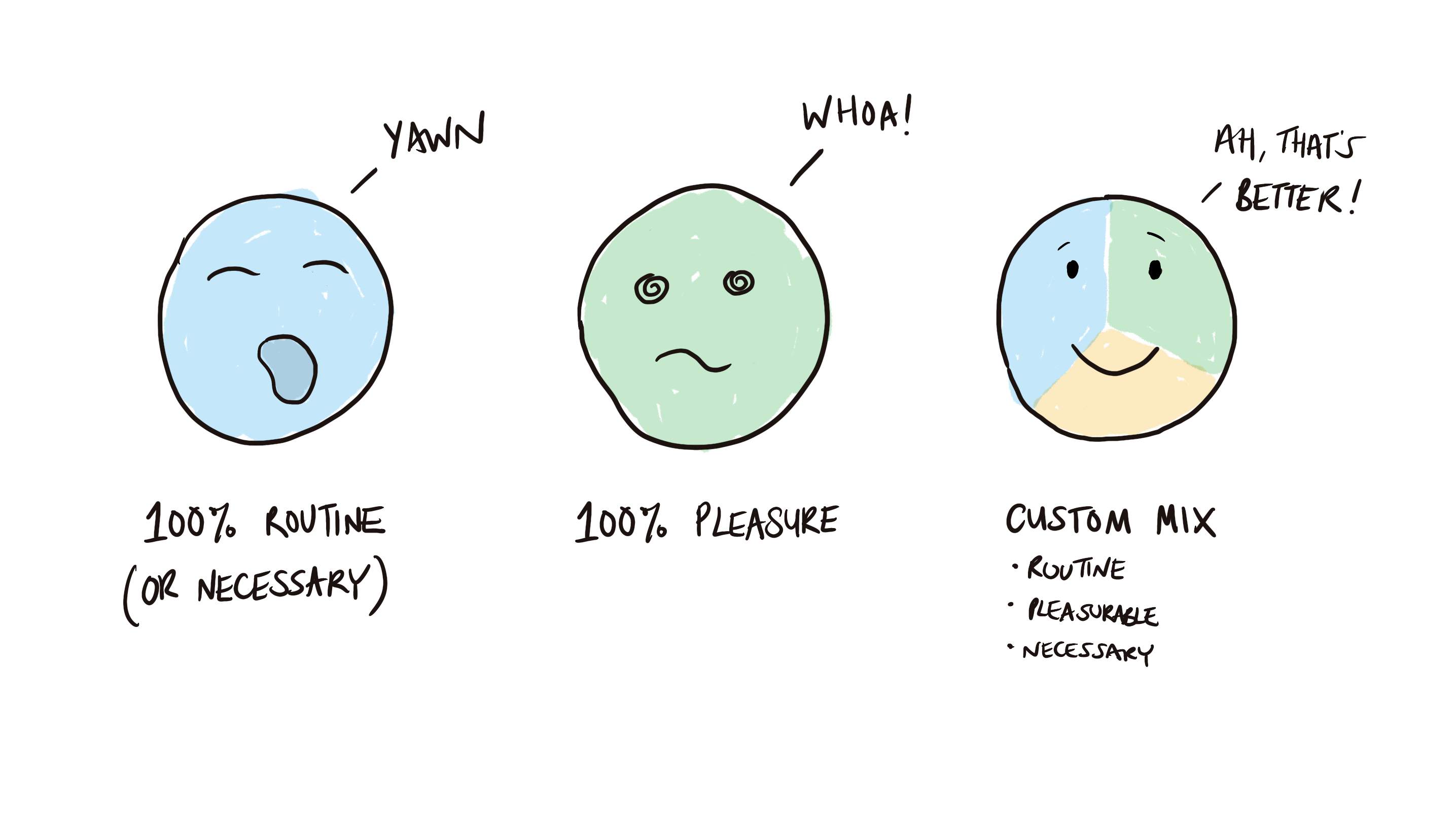TOOL: UP YOUR PLEASURE
When you’re feeling tired, everything seems like an effort. Getting through each day is a chore. The energy required to try something new or do something for yourself looks like a huge mountain. Tired, overwhelmed, or stressed, you can become caught in a vicious circle. Doing less, feeling more tired, thinking unhelpful thoughts, and getting frustrated.
You can learn how to find more energy for yourself and what to do in moments of exhaustion. I found this for myself when I was faced with recovering from severe fatigue. It took over ten years of experimenting to develop a toolkit that helps me every day. I’d like to share what I’ve learned with you in these ‘how to’ guides to specific tools. This tool is all about the relationship between energy and pleasure.
USE THIS TOOL WHEN:
How to do it:
Follow this series of prompts, write down your answers, and then make a new plan for the day.


variation: Weekly version

Variation: You can also use this same approach retrospectively. Apply the steps to look back across a whole day or even a whole week. For the weekly version, you don’t need to add in every detail of every activity for each day, just the main activities within the three blocks: morning, afternoon, and evening. Code them as routine, necessary, and pleasurable, and see how the balance is looking for you over the course of your week.

COMPLEMENTARY TOOL: STOP AND START

Related tool: If you still think you’re doing too much, check out Stop and Start, a different tool to help you edit down the amount of activity in your life.
key definitions: routine, necessary, pleasurable
Routine activities are things that you do regularly. Things like getting a shower in the morning, taking the dog for a walk, meal planning, and shopping for food.
Necessary activities are ones that are important and have a consequence if you don’t do them. Things like getting an MOT test, taking children to school, and taking medication.
Pleasurable activities are things that you enjoy. You don’t have to do them, and there isn’t a consequence if you don’t do them. You do them because of how good you feel. For me, pleasurable activities are doing yoga, taking myself on a photo walk, and writing.
For a deeper understanding of the three types of activity and how they affect our energy, check out the in depth story of the tool below.
making it work for you:
There is a lot of judgement when it comes to how we spend our time. This judgement can be external as well as internal. It affects our energy and emotions too, draining our battery. Watch out for negative self-talk.
Negative talk from others is just as draining. I’ve had snippy comments thrown my way. “If you just focused on what’s really important” and “got your priorities right.” “If you stopped doing x or y you’d have more energy”. Often the people who say this have different priorities for my time than I do. My experience is that doing things for enjoyment is key. This can be at the expense of routine or necessary tasks, especially when I really need an energy boost. I choose to question some of the necessary or routine ones, changing their label.
If you’re working with other people it does get more complex. If you don’t think a task is necessary and someone in your team* does, it can lead to friction and disagreements. Be mindful about that. It’s a useful thing to check when assigning tasks – do you think this task is necessary, or not? Being clear from the outset can help.
*or someone in your family!

TOOL IN DEPTH
the story behind the tool
Back in 2004, I started to find daily living tasks harder and harder. First I was no longer able to cook in the evenings. Then I was no longer able to walk to my workplace and struggling to get through each day. I got tired, and then more tired, until I was finally housebound. After many months I was diagnosed with an autoimmune disease that went on to have a lasting impact on my life.
Getting well took 8 months of treatment, dedicated rest and recovery. Many years of experimentation followed. One step at a time I learned to work with residual fatigue and on-going feelings of tiredness. Sometimes I made progress. Sometimes I was frustrated by setbacks. Sometimes I was stuck in bed again. I experienced phases of feeling well, and phases of feeling exhausted. Along the way, I learned some things about energy that work for people who feel tired for all sorts of reasons. Not everyone gets as tired as I was. Not everyone has an underlying long-term health condition. It is still really helpful to know how to respond when your tank is feeling empty, and how to keep it topped up.
how fatigue, stress and overwhelm affect behaviour
As part of my recovery from a recent setback, I took part in a self-help programme on pacing activity. The course uses Cognitive Behavioural Therapy (CBT) content from the University of Exeter. It focuses on using activity to get on top of low mood. I worked through the workbook Get Active, Feel Good with support from a trainee practitioner. Now, I know that some people have a negative experience of CBT. Other people think that it perpetuates the idea that how you’re feeling is all in your head. But hear me out – I learned a lot about a nuanced use of CBT from the Exeter programme. The model underlying this programme will be familiar to anyone who has had CBT. It focuses on one specific CBT skill, Behavioural Activation (BA).

In the Get Active, Feel Good programme I learned how Behavioural Activation relates to low mood and patterns of behaviour. When humans get tired we adopt patterns of behaviour that contribute to more feelings of tiredness. These same patterns of behaviour make it harder to regain energy. This doesn’t mean that tiredness is in our head; in fact it’s the opposite. The tiredness is real. Because it’s so real, it changes what we do. When we’re tired, we tend to keep up the tasks we see as necessary in our day or week, and drop the more fun ones.
Working through this with my practitioner, I could see it in action when I mapped out my activities across the week. I really didn’t have much in my week that I labelled ‘pleasurable’. I’ve seen this vicious circle play out since, too. I feel tired. I do less fun things but keep up the necessary activities. Lose a sense of achievement. And then I feel worse and lose motivation, and feel even more tired. I’ve also seen it in organisations that move to a drive for greater efficiency. It plays out in the message: “Let’s focus on the essential activities from now on, and do only what’s necessary.”

three types of activity that affect our energy differently
Because necessary tasks are the ones that have consequences, when we get tired we tend to fall back on them. “I have to do this,” we tell ourselves, as we complete one necessary task or another. Necessary tasks are important. And when we get them done we do feel a small, brief, sense of accomplishment. Routine tasks also have a role to play. But these necessary and routine tasks also use the energy that it takes to get them done, without a lasting sense of achievement.
Pleasurable tasks are the ones that make us feel good about ourselves. They are intrinsically rewarding and we enjoy them for their own sake. They give a greater and more lasting sense of achievement. These are the activities we tend to miss out when we’re tired. “I don’t have time for that,” we tell ourselves. “There are other more important things I should do instead.” We use the energy we do have on a necessary task instead of a pleasurable one.
Pleasurable tasks do use the energy it takes to do them. But here’s the magic thing – they also put a bit of energy into your tank for later. This reflects my experience. Doing things I enjoy gives me a sense of wellbeing in the short term – great! It also builds my total energy capacity in the long term. Pleasurable activities are magic. They use energy *and* add more to your battery at the same time. And they can also increase the size of your battery over time.

I’m using the example of doing a workout here because, through a series of 30 day challenges and experimenting with different types of exercise, it became a really enjoyable activity for me. Your mileage may vary!
Important note: You can’t keep adding activity on and on to your day or week. You need to let something go to add in something new. Once you have tried to apply the model without taking on more and more activities, here’s a bonus tool called ‘Stop and Start’ to help you cut down your overall list if you still need to do that.
Change hack: If you want to make a change to your feelings or thoughts or behaviour, you can start at any point in the cycle. So, for example, if you want to feel more joy, add in a behaviour that you find joyful. If you want to feel stronger, add in some affirmations or a guided relaxation that focuses on strength. Changing your behaviour can change the way you think and feel. And changing how you think can change the way you feel and behave. I’ve had positive results with both approaches, and the best results when I focus on behaviour and thinking at the same time.
Get support
If you’d like accountability to make the changes you’ve identified, or to use some other tools to get clear on what’s really important to you, let’s work together! Join the Design for Life programme to use a whole host of creative tools to get insights and act on them. Design for Life brings you tools that are tailor-made for where you are right now and the changes you want to make. And you get dedicated sessions with me to apply them and tackle obstacles that get in your way.
references
Get Active, Feel Good! (2013). Paul Farrand, Adrian Taylor, Colin Greaves and Claire Pentecost. Funded by the National Prevention Research Initiative (NPRI-4). Available online. (Accessed 30/07/2021).

